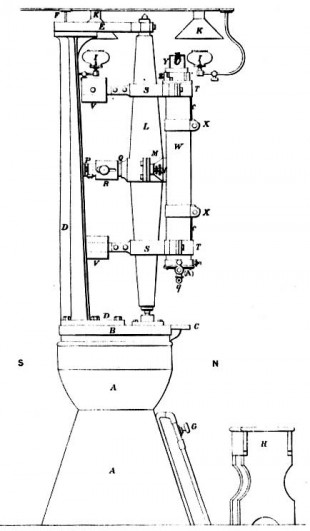…where east meets west
- Home
- Brief History
- The Greenwich Meridian
- Greenwich
(1675–1958) - Herstmonceux
(1948–1990) - Cambridge
(1990–1998) - Outstations (1822–1971)…
- – Chingford (1822–1924)
- – Deal
(1864–1927) - – Abinger
(1923–1957) - – Bristol & Bradford on Avon
(1939–1948) - – Bath
(1939–1949) - – Hartland
(1955–1967) - – Cape of Good Hope
(1959–1971)
- Administration…
- – Funding
- – Governance
- – Inventories
- – Pay
- – Regulations
- – Royal Warrants
- Contemporary Accounts
- People
- Publications
- Science
- Technology
- Telescopes
- Chronometers
- Clocks & Time
- Board of Longitude
- Libraries & Archives
- Visit
- Search
Telescope: Airy’s Water Telescope (1870)
The Astronomer Royal, George Airy, designed this Water Telescope specifically to determine whether the measured value of the constant of aberration depended on the depth of refracting medium in the optics.Airy’s motivation for carrying out the investigation was triggerred by the publication of a pamphlet by Professor Wilhelm Klinkerfues in which he claimed to have shown that the constant of aberration was affected. This was important not only for the correct determination of star positions, but for the whole treatment of the Undulatory Theory of light together with the computed value for the velocity of light. After two years of observations with his instrument, Airy concluded that Klinkerfues was wrong.
Design of the telescope
Airy published a full description of the telescope complete with accompanying diagrams in the introduction to the 1871 volume of Greenwich Observations under the title: The History and Description of the Water Telescope. This departed from his normal practice of publishing such descriptions as appendices to the Greenwich Volumes.
The telescope was mounted as a zenith instrument with the whole of the telescope tube, from the lower surface of the object-glass to a plane glass closing the lower end of the tube filled with water. The length of the water column, (W in the diagram) was 35.3 inches. The curvatures of the surfaces of the two lenses constituting the object-glass, adapted in conjunction with the water were computed by Airy and verified by his First Assistant, Edward Stone, to correct for spherical and chromatic aberration. The instrument was fitted with a micrometer which was used for double observations in reversed positions of the instrument. The reference to the vertical was determined by two spirit levels. Although signed Troughton & Simms, it was William Simms who liaised with Airy on the instruments construction. Airy’s History and Description should be consulted for further details of the design and the telescope’s method of use.
Location of the telescope
The telescope was mounted in what Airy referred to as the ‘Occasional Observatory’. This was a hut that had previously served as ‘Struve’s Observatory’. Originally erected in the Magnetic Ground in 1843/4, for use in the Pukowa-Altona-Greenwich longitude determination, Struve’s Observatory had been taken down in 1862/3 when the Magnetic Offices were built. Airy had the hut re-erected in 1870 ‘in the northern part of the South Ground’ and fitted out with a stone pier (A) and gas supply (G). Airy gave the location of the instrument as 340 feet south of the Transit Circle. The building does not appear on any of the known plans and appears to have been taken down by 1885, perhaps because it had occupied the site of the later Lassell Dome which was completed in 1884. The telescope itself was dismounted in August 1873. In May 1894, according to Christie’s Journal (RGO7/30), the telescope was mounted by Mr Simms Jnr. in the basement of the South Wing of his New Physical Building (South Building). On the face of it, it appears to have been moved at some point during the next few years. In his book Greenwich Observatory, (which was published in 1900), Maunder states that the telescope was, at that time, on the ground floor of the building’s central octagon. Whether or not the telescope was actually moved, or whether each writer used a different way of describing the same location, is not clear.
The telescope was presented (together with Airy’s Reflex Zenith Tube and the water clock that had formerly been used to drive the 28-inch Refractor) to the Science Museum in 1937/8. In the 1960s it was sent to the National Maritime Museum for display in the Meridian Building. It is currently in the National Maritime Museum’s store (Object ID:AST1000). It has not so far been possible to establish if the telescope has been permanently transferred to the National Maritime Museum or is on loan from the Science Museum.
Published observations
Further reading
On a Supposed Alteration in the Amount of Astronomical Aberration of Light, Produced by the Passage of the Light through a Considerable Thickness of Refracting Medium. G.B.Airy, Proc. R. Soc. Lond. January 1, (23 Nov 1871) pp.35–39
On the theory of Aberration, H. C. Plummer, Monthly Notices of the Royal Astronomical Society, Vol. 69, (1909) pp.496–508
Airy’s water telescope, H.P. Hollis, The Observatory, Vol. 60, pp.103–107 (1937)
Airy's zenith telescopes and “the birth-star of modern astronomy”, G.E. Satterthwaite, Journal of Astronomical History and Heritage (ISSN 1440-2807), Vol. 6, No. 1, pp.13–26 (2003)
Water-filled telescopes, E. Antonello (Jan 2014)
© 2014 – 2025 Graham Dolan
Except where indicated, all text and images are the copyright of Graham Dolan
